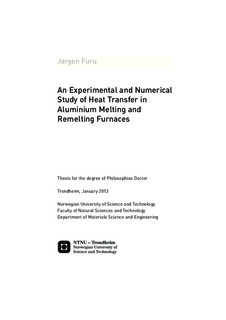| dc.contributor.author | Furu, Jørgen | nb_NO |
| dc.date.accessioned | 2014-12-19T13:27:01Z | |
| dc.date.available | 2014-12-19T13:27:01Z | |
| dc.date.created | 2013-02-21 | nb_NO |
| dc.date.issued | 2013 | nb_NO |
| dc.identifier | 606982 | nb_NO |
| dc.identifier.isbn | 978-82-471-4152-6 (printed ver.) | nb_NO |
| dc.identifier.isbn | 978-82-471-4153-3 (electronic ver.) | nb_NO |
| dc.identifier.uri | http://hdl.handle.net/11250/249225 | |
| dc.description.abstract | This work has been a combined experimental and numerical modeling effort aimed to help in the understanding of heat transfer processes when melting aluminium. In addition a newly developed type of oxy-fuel burner was investigated. Objectives set for this project include improving energy efficiency in a typical industry furnace used today and looking at possible new technology to realize higher efficiencies than normally obtained. As a starting point a literature review was done to get an overview of furnaces and technology used in aluminium remelting and recycling. The most commonly used furnace today for aluminium melting and remelting is the reverberatory furnace which was the focus of this work as well. Understanding the interaction of parameters influencing heat transfer and quantifying how heat is transferred in the furnace are key elements to be able to optimize energy efficiency. Reverberatory furnaces are usually heated by gas burners, more specifically with cold air as oxidizer. Recent developments in burner technology using pure oxygen as oxidizer has showed some promising results and was investigated in experiments and numerical models.
Melting experiments were carried out in a controlled environment in a 500 kg laboratory scale furnace as a basis for understanding the heat transfer mechanisms and quantifying radiation and convection contributions when melting aluminium. The experiments also served as a reference for a numerical 1-dimensional heat transfer model along with more advanced 3-dimensional computational fluid dynamics (CFD) models using a commercial software package. Phenomena as turbulent flow, combustion, convection, conduction and radiation were included in the models along with latent heat release when melting metal. The influence and impact of physical parameters on the heat transfer could be determined in the numerical models and provided a more detailed analysis of the processes in the furnace.
A newly developed Low Temperature Oxy-fuel (LTOF) burner was investigated and compared to a conventional cold air-fuel burner in a pilot scale furnace. Measurements of flame and furnace temperatures, gas composition and heat fluxes were done for both burners at two different input levels. Heating experiments of aluminium samples were performed to look at the difference between the burners for aluminium heating and melting applications. 3-dimensional CFD models were developed to determine unknown quantities such as metal emissivity and quantification of radiation and convection heat transfer. The experiments also confirmed the validity of the numerical models.
Finally a full scale reverberatory industry furnace was modeled using a 3-dimensional CFD model. The air-fuel burners currently installed in the furnace was replaced by LTOF burners in the numerical model. The performance was compared to a previously published numerical model of the same furnace using air-fuel burners for two different metal configurations in the furnace. The influence of parameters such as burner input, metal emissivity, furnace wall emissivity and a dross layer was studied.
The key factor when making improvements in furnaces is understanding the fundamental heat transfer processes in existing technology. The experimental and numerical modeling work presented in this thesis has studied these phenomena and created a basis from which further investigations into furnace efficiency in aluminium remelting and recycling can be done. The performance of a new type of burner was also analyzed and explained through experiments and modeling. | nb_NO |
| dc.language | eng | nb_NO |
| dc.publisher | Norges teknisk-naturvitenskapelige universitet, Fakultet for naturvitenskap og teknologi, Institutt for materialteknologi | nb_NO |
| dc.relation.ispartofseries | Doktoravhandlinger ved NTNU, 1503-8181; 2013:30 | nb_NO |
| dc.title | An Experimental and Numerical Study of Heat Transfer in Aluminium Melting and Remelting Furnaces | nb_NO |
| dc.type | Doctoral thesis | nb_NO |
| dc.contributor.department | Norges teknisk-naturvitenskapelige universitet, Fakultet for naturvitenskap og teknologi, Institutt for materialteknologi | nb_NO |
| dc.description.degree | PhD i materialteknologi | nb_NO |
| dc.description.degree | PhD in Materials Science and Engineering | en_GB |
